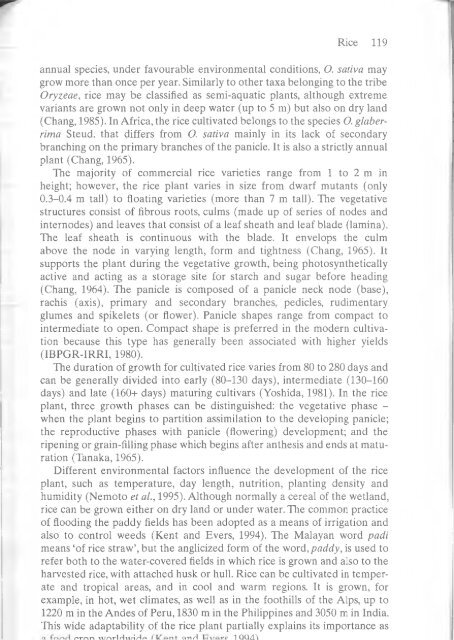Arendt und Zannini - 2013 - Cereal grains for the food and beverage industries
Arendt und Zannini - 2013 - Cereal grains for the food and beverage industries
Arendt und Zannini - 2013 - Cereal grains for the food and beverage industries
You also want an ePaper? Increase the reach of your titles
YUMPU automatically turns print PDFs into web optimized ePapers that Google loves.
Rice 119<br />
annual species, <strong>und</strong>er favourable environmental conditions, O. sativa may<br />
grow more than once per year. Similarly to o<strong>the</strong>r taxa belonging to <strong>the</strong> tribe<br />
Oryzeae, rice may be classified as semi-aquatic plants, although extreme<br />
variants are grown not only in deep water (up to 5 m) but also on dry l<strong>and</strong><br />
(Chang, 1985). In Africa, <strong>the</strong> rice cultivated belongs to <strong>the</strong> species O. glaberrima<br />
Steud. that differs from O. sativa mainly in its lack of secondary<br />
branching on <strong>the</strong> primary branches of <strong>the</strong> panicle. It is also a strictly annual<br />
plant (Chang, 1965).<br />
The majority of commercial rice varieties range from 1 to 2 m in<br />
height; however, <strong>the</strong> rice plant varies in size from dwarf mutants (only<br />
0.3-0.4 m tall) to floating varieties (more than 7 m tall). The vegetative<br />
structures consist of fibrous roots, culms (made up of series of nodes <strong>and</strong><br />
internodes) <strong>and</strong> leaves that consist of a leaf sheath <strong>and</strong> leaf blade (lamina).<br />
The leaf sheath is continuous with <strong>the</strong> blade. It envelops <strong>the</strong> culm<br />
above <strong>the</strong> node in varying length, <strong>for</strong>m <strong>and</strong> tightness (Chang, 1965). It<br />
supports <strong>the</strong> plant during <strong>the</strong> vegetative growth, being photosyn<strong>the</strong>tically<br />
active <strong>and</strong> acting as a storage site <strong>for</strong> starch <strong>and</strong> sugar be<strong>for</strong>e heading<br />
(Chang, 1964). The panicle is composed of a panicle neck node (base),<br />
rachis (axis), primary <strong>and</strong> secondary branches, pedicles, rudimentary<br />
glumes <strong>and</strong> spikelets (or flower). Panicle shapes range from compact to<br />
intermediate to open. Compact shape is preferred in <strong>the</strong> modern cultivation<br />
because this type has generally been associated with higher yields<br />
(IBPGR-IRRI, 1980).<br />
The duration of growth <strong>for</strong> cultivated rice varies from 80 to 280 days <strong>and</strong><br />
can be generally divided into early (80-130 days), intermediate (130-160<br />
days) <strong>and</strong> late (160-t- days) maturing cultivars (Yoshida, 1981). In <strong>the</strong> rice<br />
plant, three growth phases can be distinguished: <strong>the</strong> vegetative phase -<br />
when <strong>the</strong> plant begins to partition assimilation to <strong>the</strong> developing panicle;<br />
<strong>the</strong> reproductive phases with panicle (flowering) development; <strong>and</strong> <strong>the</strong><br />
ripening or grain-filling phase which begins after an<strong>the</strong>sis <strong>and</strong> ends at maturation<br />
(Tanaka, 1965).<br />
Different environmental factors influence <strong>the</strong> development of <strong>the</strong> rice<br />
plant, such as temperature, day length, nutrition, planting density <strong>and</strong><br />
humidity (Nemoto et ai, 1995). Although normally a cereal of <strong>the</strong> wetl<strong>and</strong>,<br />
rice can be grown ei<strong>the</strong>r on dry l<strong>and</strong> or <strong>und</strong>er water. The common practice<br />
of flooding <strong>the</strong> paddy fields has been adopted as a means of irrigation <strong>and</strong><br />
also to control weeds (Kent <strong>and</strong> Evers, 1994). The Malayan word padi<br />
means ‘of rice straw’, but <strong>the</strong> anglicized <strong>for</strong>m of <strong>the</strong> vtord,paddy, is used to<br />
refer both to <strong>the</strong> water-covered fields in which rice is grown <strong>and</strong> also to <strong>the</strong><br />
harvested rice, with attached husk or hull. Rice can be cultivated in temperate<br />
<strong>and</strong> tropical areas, <strong>and</strong> in cool <strong>and</strong> warm regions. It is grown, <strong>for</strong><br />
example, in hot, wet climates, as well as in <strong>the</strong> foothills of <strong>the</strong> Alps, up to<br />
1220 m in <strong>the</strong> Andes of Peru, 1830 m in <strong>the</strong> Philippines <strong>and</strong> 3050 m in India.<br />
This wide adaptability of <strong>the</strong> rice plant partially explains its importance as<br />
r»rr>t^ wtrwIrixttiHo onH 1QQzl^

















